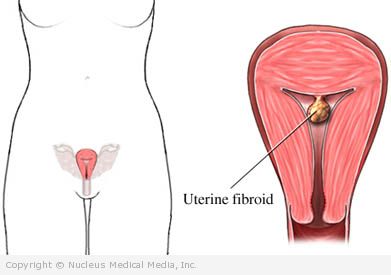(Fibroids; Leiomyoma; Myoma; Fibromyoma)
Uterine fibroids – Definition
Fibroids are benign (noncancerous) growths in the wall of the uterus. The uterus is the reproductive organ where a fetus grows. Fibroids often grow into the uterine cavity. In rare cases, they may protrude from the uterus toward nearby organs. Fibroids may be very small or may grow to eight or more inches in diameter. Usually more than one fibroid is present.
Uterine fibroids – Causes
The cause of fibroids is unknown. Genetics and changes in substances that control blood vessel growth may make some women prone to fibroids. Female reproductive hormones stimulate fibroid growth. Fibroids grow larger during pregnancy then shrink after childbirth. Fibroids become less of a problem after menopause. But, symptoms may return with hormone replacement therapy.
Uterine fibroids – Risk Factors
These risk factors increase your chance of developing fibroids:
- Sex: female
- Age: 13-50 years old (childbearing age)
- Race: Black
Uterine fibroids – Symptoms
Symptoms range from none at all to mild or severe. This depends on the size and location of the growths.
Symptoms may include:
- Pelvic pain
- Feeling of pelvic pressure
- Heavy menstrual bleeding
- Clots in menstrual flow
- Long periods
- Bleeding between periods
- Increased cramping during periods
- Pain during sex
- Frequent need to urinate
- Constipation
- Bloating
- Enlarged uterus (giving the appearance of pregnancy)
- Low back or leg pain
- Infertility by blocking the fallopian tubes
- Miscarriage
Iron-deficiency anemia may develop if bleeding is heavy.
Uterine fibroids – Diagnosis
Doctors find most fibroids during routine pelvic exams. An confirms the diagnosis. A may be done to obtain clearer images. A
To confirm the diagnosis, your doctor may order other imaging tests or procedures, such as:
- Abdominal ultrasound
- Transvaginal ultrasound — a smooth probe is inserted into the vagina to show images of the organs in the pelvic area
- CT scan or magnetic resonance imaging(MRI) — may be ordered in complex cases
- Hysteroscopy — a long, thin tool with a camera on one end is inserted into the uterus
Uterine fibroids – Treatment
Most women with fibroids have no symptoms and do not need treatment. Your doctor may recommend “watchful waiting.” This is done to monitor the size and growth of the fibroids at regular intervals using ultrasound.
Treatments include:
Pain Medication
Your doctor may recommend:
- Over-the-counter pain relievers to ease mild symptoms
- Nonsteroidal anti-inflammatory drugs (NSAIDs) to reduce inflammation and relieve cramping
- Prescription pain medicine (may be needed in some cases)
Hormonal Therapy
Hormone medicines, which decrease estrogen levels, are an option if you are not trying to become pregnant. The drugs shrink fibroids. The drugs also lessen the pain by decreasing the supply of estrogen to the uterus. However, fibroids can return once you stop taking the drugs. These drugs are often used to reduce fibroid size prior to surgery.
Procedures
Surgery is considered if:
- The uterus becomes extremely large.
- The fibroids are interfering with fertility.
- Symptoms are severe.
Surgical procedures include:
- Myomectomy — An incision is made in the abdomen to expose the uterus and the fibroids are removed.
- Hysterectomy — This involves the removal of the entire uterus. You will be unable to have children if you have this surgery.
Other options include:
- Uterine fibroid ablation — This is a minimally invasive procedure that involves blocking the blood flow to the fibroids, which causes them to shrink.
- Focused ultrasound therapy — Energy is centered on the fibroid to destroy it. This procedure may not be ideal for patients who are very overweight, have very large fibroids, or have extensive scars from prior abdominal surgeries.
If you are diagnosed with uterine fibroids, follow your doctor’s instructions.
Uterine fibroids – Prevention
There are no guidelines for preventing fibroids.

